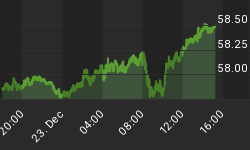"People who have realized that this is a dream imagine that it is easy to wake up, and are angry with those who continue sleeping, not considering that the whole world that environs them does not permit them to wake. Life proceeds as a series of optical illusions, artificial needs and imaginary sensations." ~ Alexander Herzen, 1812-1870, Russian Journalist, Political Thinker
A lot of noise has been made each time the Dow traded to a new 52 week high and the same chorus was once again sung when it put in back to back new highs on Monday and Tuesday. A very short and simple calculation reveals that all these new highs are illusory in nature; like a mirage in the desert, it looks real but when you try to examine it from close, it vanishes.
To illustrate the open point, let's go back one year to Nov 2008.
One year ago on the high for the Dow in Nov of 2008 was 9625. One year ago the Dollar index put in a high of 88.41 (Nov 21, 2008). The dollar closed yesterday at 75.13, and so it is trading roughly 15% lower than it was one year ago.
In order for the Dow to put in a new true high, it would have to trade above the adjusted value of 9625; we have to adjust the value as the dollar is trading at a lower level than it was a year ago. Thus if one adds 15% to the 9625, one gets 11068. Hence, we can effectively conclude that the Dow is still a rather long way from putting in a new true high and the so called 5 new highs it has put in the last 30 days are all illusory. It makes no sense to compare what the Dow is doing today to what the Dow did yesterday, unless the currency it's trading in is taken into consideration.
Now let's look at Gold and Silver.
In the month of Nov, 2008, Gold's highest close was 818. Yesterday Gold closed at roughly 1100. Thus in one year it is up roughly 34%.
Silver's highest close in Nov 2008 was 10.35. Yesterday it closed at 17.48 and so is showing a 1 year gain of 68%.
Thus both Gold and Silver have more than compensated for the drop in the value of the dollar. To make matters even worse the Dow would actually need to trade significantly higher just to break even; in other words, it is actually trading much lower than it was in the same time period one year ago.
Conclusion
The same exercise can be performed on a host of other commodities and the results will indicate that in most cases the underlying commodity has more than compensated for the loss in the value of the dollar. Now if one performs the same exercise on many of the stocks that are rallying to new 52 week highs, one will find that when adjusted for the weaker dollar, most stocks are not trading at new highs, unless they happen to be stocks that deal with hard assets. A perfect example of an illusory all time new highs is Amazon.
Long term the implications are rather negative; the Dow's inability to even compensate for the lower dollar means that when this market starts to correct again, the move down is going to be very hard and vicious. There is even a good chance that the March 2009 lows might not hold.
This simple exercise indicates that investing in indices such as the Dow, SP500, NASDAQ, etc., makes no sense as your rate of return would have been negative. It makes far more sense to put your money into bullion or into companies that deal with hard assets such as Gold, Silver, copper, Zinc, Vanadium, etc. As the commodity's sector in general has experienced a pretty strong run, traders looking to open new positions should wait for pull backs before deploying new money.
"It isn't safe to sit in judgment upon another person's illusion when you are not on the inside. While you are thinking it is a dream, he may be knowing it is a planet." ~ Mark Twain, 1835-1910, American Humorist, Writer
Related articles:
Long Term Analysis of the Dow
Dow's 52 week highs not confirmed
The Dow: ominous parallels to the 1929-1930 era















